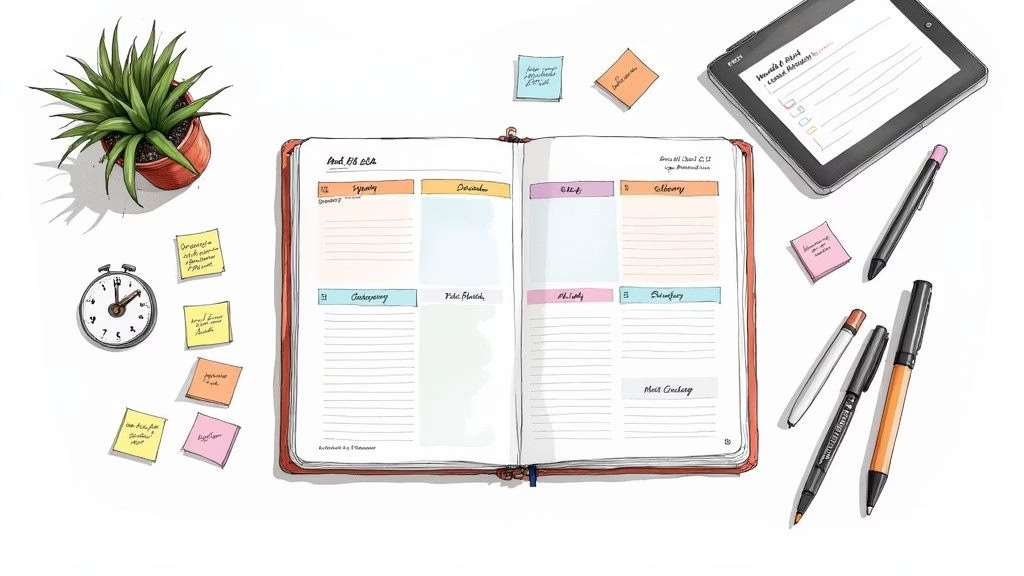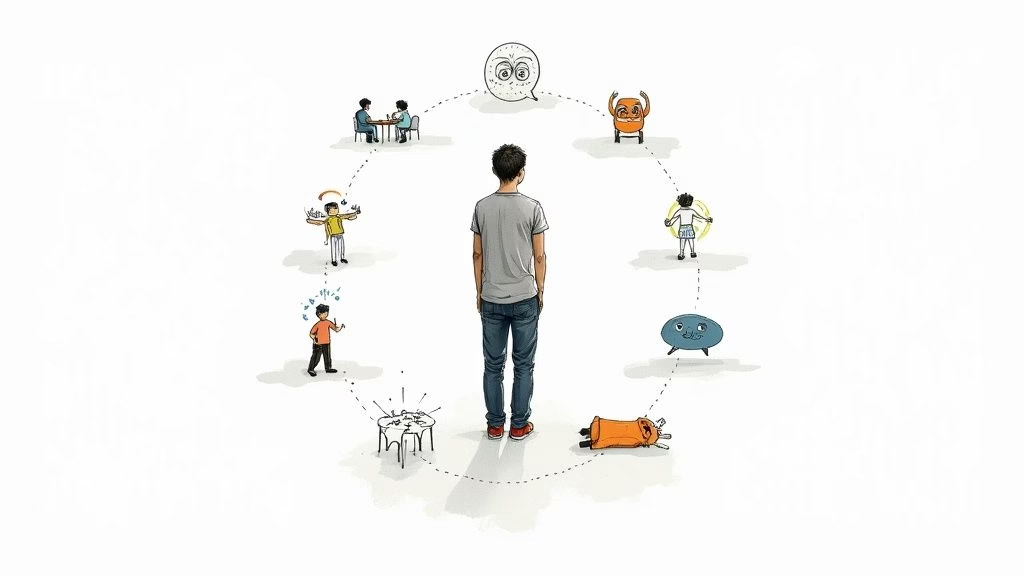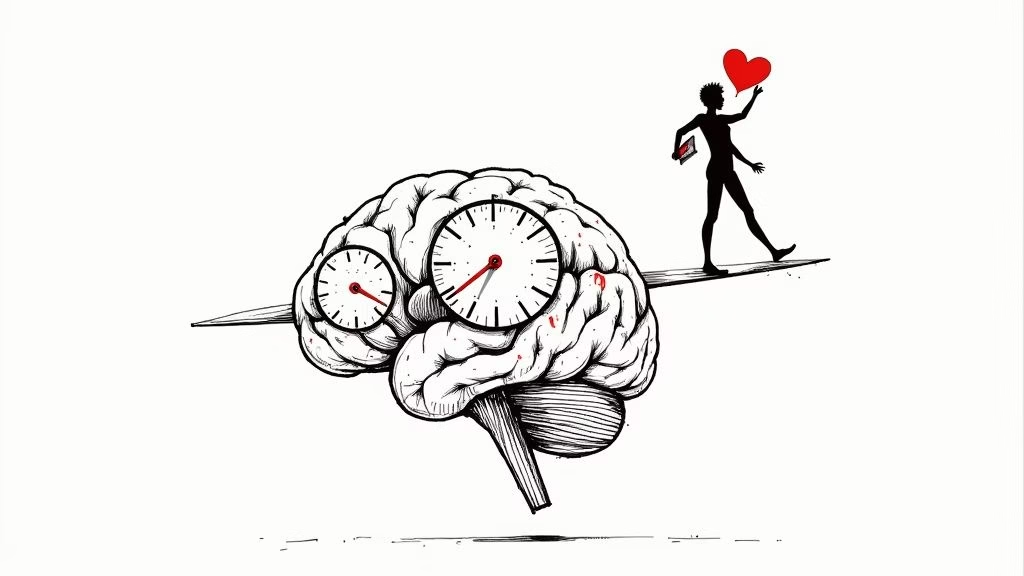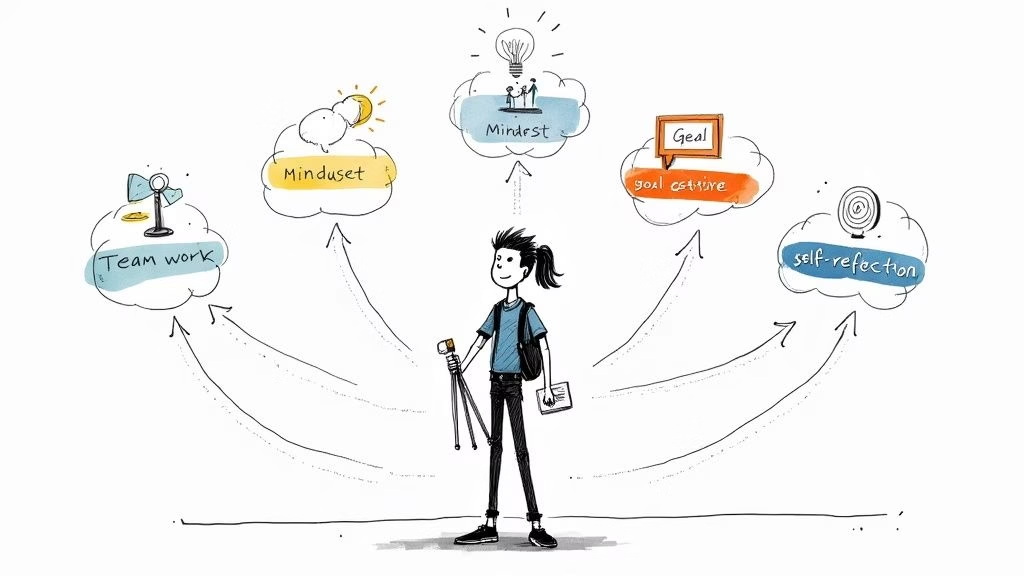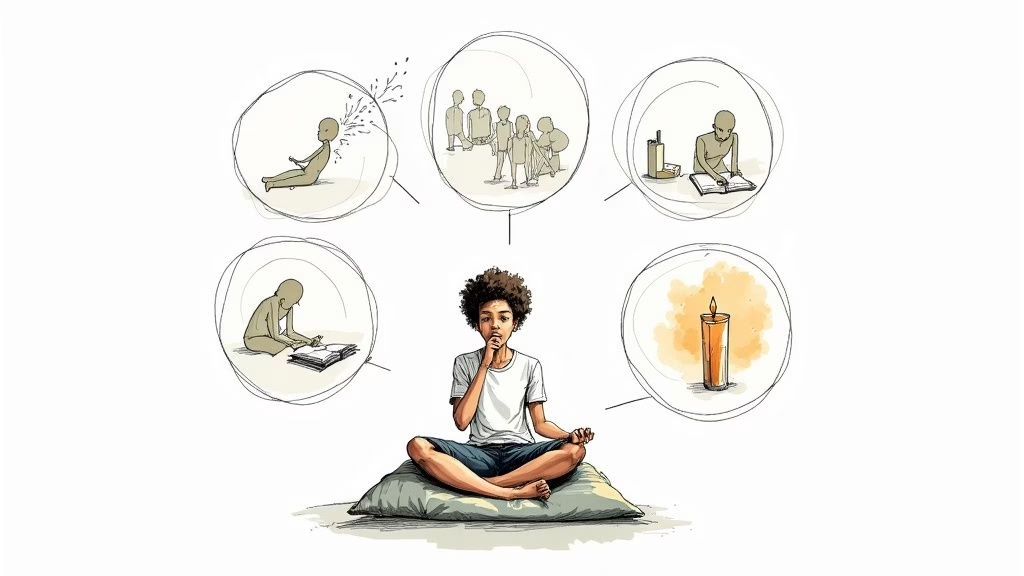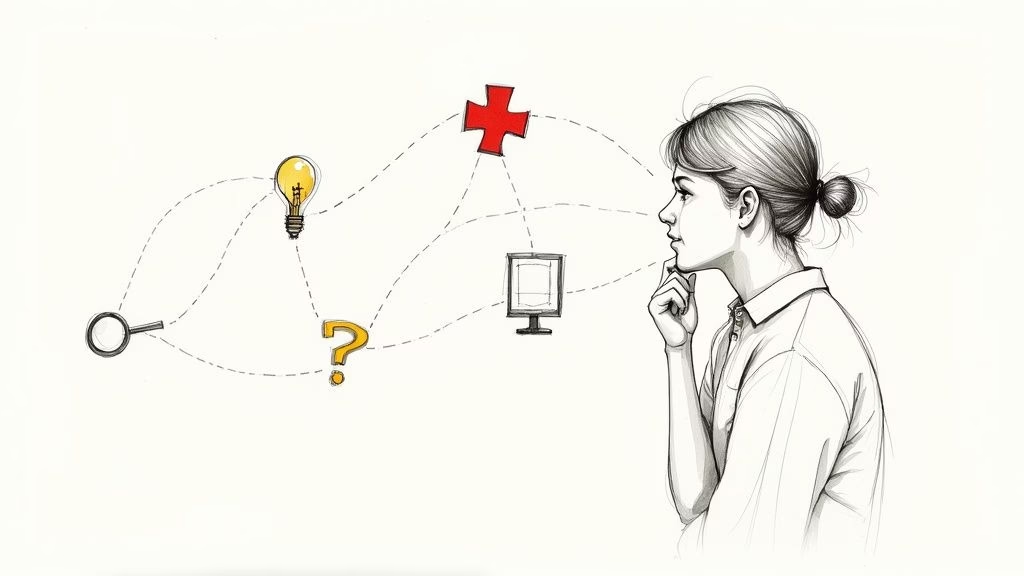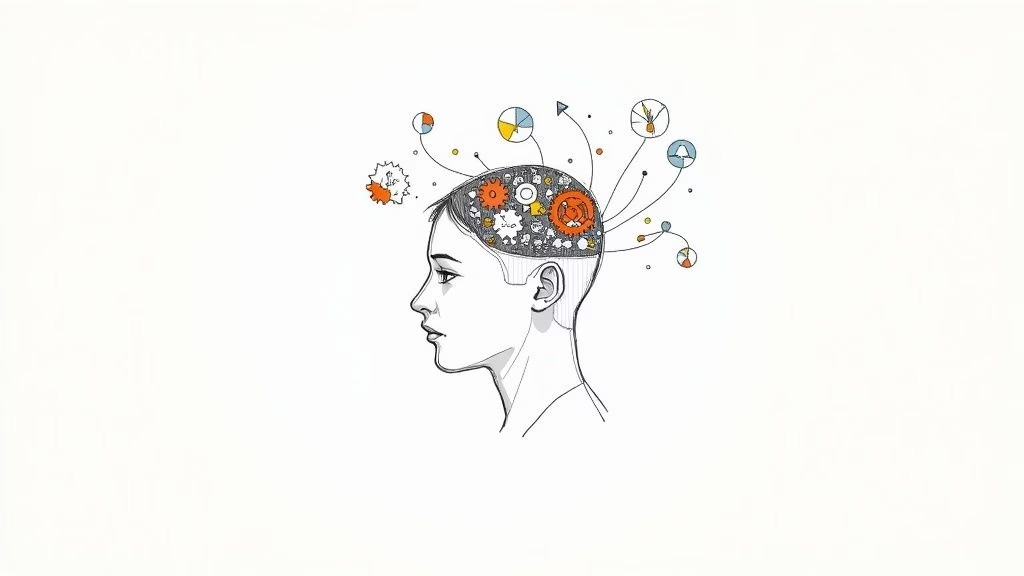The student experience is often a balancing act between demanding coursework, extracurricular commitments, social pressures, and future planning. From navigating tough exams and college applications to managing procrastination and maintaining motivation, the sources of stress are abundant and can feel overwhelming. This constant pressure can significantly impact not only academic performance but also mental and emotional well-being, leading to anxiety, burnout, and diminished self-esteem. For parents, watching a teen struggle with these challenges can be equally difficult, leaving them searching for effective ways to provide support.
This guide is designed to be a comprehensive, practical resource for both students and their families. We move beyond generic advice to provide a detailed roundup of evidence-based stress reduction techniques for students. You won't find vague suggestions here; instead, you'll discover actionable strategies, specific implementation steps, and real-life scenarios to help you integrate these practices into your daily routine. We will explore a variety of methods that address the root causes of academic and personal stress, offering fresh perspectives on proven approaches.
Throughout this article, you will learn how to:
- Implement mindfulness and deep breathing to calm an anxious mind before an exam.
- Structure your time effectively to combat procrastination and regain a sense of control.
- Leverage physical activity, nutrition, and sleep to build a strong foundation for mental resilience.
- Foster social connections that provide meaningful support during challenging times.
We will also include dedicated tips for parents on how to best support their teens, alongside resources and research links for further exploration into teen mental health. Our goal is to equip you with a versatile toolkit of effective strategies, empowering you to not just cope with stress but to thrive academically and personally.
1. Mindfulness Meditation
Mindfulness meditation is a powerful mental training practice that teaches students to slow down, turn inward, and pay attention to the present moment without judgment. Rather than trying to stop thinking or empty the mind, this technique involves observing thoughts, feelings, and bodily sensations as they arise and pass. This creates a mental buffer between a stressful trigger, like an upcoming exam, and your emotional reaction, helping you respond more calmly and thoughtfully instead of being overwhelmed by anxiety.
This practice is one of the most effective stress reduction techniques for students because it directly targets the cognitive habits that fuel procrastination and academic anxiety. By becoming more aware of your mental patterns, you can catch the impulse to procrastinate before it takes hold and gently redirect your focus back to your studies.
How to Implement Mindfulness
Getting started is simpler than you might think. You don't need special equipment or a lot of time.
- Start Small: Dedicate just 5-10 minutes each day. Consistency is more important than duration. Try using a guided meditation app like Headspace or Calm to learn the basics.
- Create a Routine: Practice at the same time every day, such as right after you wake up or before you start your homework. This helps build a sustainable habit.
- Focus on Your Breath: When you notice your mind wandering, which it will, gently and non-judgmentally guide your attention back to the sensation of your breath.
- Join a Community: Look for on-campus meditation groups or online communities. Practicing with others can provide support and accountability.
Why It Works for Students
Mindfulness is not just about relaxation; it’s about building mental resilience. Universities like UCLA and Harvard have integrated mindfulness programs to help students manage academic pressure and prevent burnout. The practice enhances focus, improves emotional regulation, and boosts working memory, all of which are critical for academic success. For a deeper dive into the specific benefits for younger students, you can explore more about meditation for teens. By regularly engaging in mindfulness, students can develop a stronger sense of control over their stress, leading to improved motivation and a healthier relationship with their schoolwork.
2. Deep Breathing Techniques
Deep breathing techniques are simple yet powerful exercises that directly engage the body's natural relaxation response. By consciously controlling your breath, you activate the parasympathetic nervous system, which acts like a brake on the body's stress-fueled "fight or flight" mode. This process slows your heart rate, lowers blood pressure, and reduces cortisol levels, offering immediate relief during high-pressure moments like standing up for a presentation or sitting down for an exam.
This method is one of the most accessible stress reduction techniques for students because it requires no equipment and can be done anywhere, anytime. When you feel the physical symptoms of anxiety building up, such as a racing heart or shallow breath, controlled breathing provides a physiological reset. It anchors you in the present, preventing your mind from spiraling into anxious thoughts about past mistakes or future failures, which is a common trigger for academic procrastination.
How to Implement Deep Breathing
You can master these techniques in minutes and use them to manage stress on the spot.
- Practice 4-7-8 Breathing: Popularized by Dr. Andrew Weil, this technique is profoundly calming. Inhale through your nose for 4 seconds, hold your breath for 7 seconds, and exhale slowly through your mouth for 8 seconds.
- Try Box Breathing: Used by Navy SEALs for focus under pressure, this method involves a simple rhythm. Inhale for 4 counts, hold for 4 counts, exhale for 4 counts, and hold again for 4 counts.
- Set Reminders: Use your phone to set a few alarms throughout the day to take five deep, intentional breaths. This builds a habit of checking in with your body and releasing accumulated tension.
- Use It Strategically: Practice a few rounds before entering an exam hall, during a challenging homework session, or before a difficult conversation.
Why It Works for Students
Deep breathing is a portable stress-management tool that provides immediate physiological benefits. Institutions like Stanford University recognize its power, actively teaching students box breathing before finals to enhance focus and performance. This isn't just about calming down; it's about gaining conscious control over your body's response to stress. For students, this means being able to think more clearly and make better decisions when academic pressure is high. Parents can support this by practicing alongside their teens, modeling a healthy coping mechanism for managing life's inevitable stressors and building a foundation of emotional resilience.
3. Regular Physical Exercise
Regular physical exercise is a structured way to combat stress by fundamentally altering your body's chemistry. It works by reducing stress hormones like cortisol and adrenaline while simultaneously triggering the release of endorphins, which are powerful, natural mood elevators. This process provides a healthy outlet for pent-up frustration and anxiety, directly improving both physical and mental well-being.
Engaging in physical activity is one of the most effective stress reduction techniques for students as it directly counteracts the mental fatigue and lethargy that often lead to procrastination. A brisk walk or a quick workout can break the cycle of stress-induced inaction, resetting your brain and making it easier to return to your studies with renewed energy and focus. As Dr. John Ratey highlights in his book, "Spark," exercise essentially builds a more resilient and better-performing brain.
How to Implement Physical Exercise
Integrating exercise into a packed student schedule doesn't require a huge time commitment or expensive gym membership. The key is finding a sustainable routine.
- Start with Short Bursts: Aim for 20-30 minutes of moderate activity, like jogging or cycling, just 3-4 times a week to start feeling the benefits.
- Find Activities You Enjoy: Consistency is crucial. If you hate running, don't force it. Try dancing, team sports, hiking, or swimming to keep your motivation high.
- Leverage Campus Resources: Most schools offer free or low-cost access to recreation centers, fitness classes, and sports clubs. These are great ways to stay active and meet new people.
- Schedule Active Study Breaks: Instead of scrolling through your phone, take a 10-minute walk during long study sessions. This can improve information retention and reduce mental exhaustion.
- Partner Up: Exercise with friends for added motivation, accountability, and social connection, which is another powerful stress reducer.
Why It Works for Students
Exercise is a potent tool for enhancing academic performance. Many universities have recognized this connection, with programs like Stanford's Cardinal Wellness integrating fitness directly into student life to manage academic pressure. For parents looking to support their teen, encouraging physical activity can be one of the most impactful ways to help them manage stress and build confidence. It improves sleep quality, boosts cognitive function, and provides a tangible sense of accomplishment, all of which are essential for navigating the challenges of school and preventing burnout.
4. Time Management and Organization
Effective time management and organization are foundational skills that directly combat the feeling of being overwhelmed by academic and personal responsibilities. This technique involves systematically planning, prioritizing, and structuring your tasks to create a sense of control and predictability. Rather than reacting to deadlines as they appear, a well-organized student proactively allocates time for studying, assignments, and personal life, preventing the last-minute cramming that fuels anxiety and burnout.
This methodical approach is one of the most powerful stress reduction techniques for students because it addresses the root cause of much academic stress: procrastination and a lack of clarity. When you have a clear plan, the impulse to procrastinate weakens, as the path forward is broken into manageable steps. This structure not only boosts productivity but also carves out protected time for rest and socializing, which is essential for mental health.
How to Implement Time Management
Getting started involves adopting a few key habits and using simple tools to bring order to your schedule. The goal is to build a system that works for you.
- Break It Down: Divide large projects, like a research paper or exam preparation, into smaller, concrete tasks. This makes them less intimidating and easier to start.
- Use the Pomodoro Technique: Work in focused 25-minute intervals, followed by a 5-minute break. This method, developed by Francesco Cirillo, enhances concentration and prevents mental fatigue.
- Schedule Weekly Reviews: Dedicate 30 minutes each Sunday to review upcoming deadlines, plan your week, and adjust priorities. This creates a roadmap and reduces Monday morning anxiety.
- Leverage Digital Tools: Use apps like Notion, Trello, or Todoist to organize tasks and deadlines. A digital calendar with notifications can also be a lifesaver for remembering important dates.
Why It Works for Students
Mastering time management builds a student's sense of agency and self-efficacy, which are critical for motivation and mental well-being. Academic institutions like Cornell University's Learning Strategy Center actively teach these skills to help students thrive. By creating and following a structured plan, students learn to manage expectations, balance competing demands, and avoid the cycle of procrastination-induced stress. This proactive approach frees up mental energy, allowing for deeper focus on learning rather than constant worry about what's next. For a more comprehensive guide, you can explore detailed strategies for time management for students. Ultimately, organizing your time is organizing your mind, creating a calm and focused environment for academic success.
5. Social Support and Connection
Human beings are inherently social, and building meaningful connections is a fundamental component of emotional well-being. Social support involves nurturing relationships with peers, family, and mentors who provide emotional validation, practical help, and a sense of belonging. This network acts as a powerful buffer against academic pressure, loneliness, and burnout by activating the release of oxytocin, a hormone that counteracts the stress hormone cortisol and fosters feelings of trust and security.
This approach is one of the most vital stress reduction techniques for students because isolation can amplify feelings of being overwhelmed. Having a strong support system provides not just an outlet for venting frustrations but also diverse perspectives that can help you reframe academic challenges, combat procrastination through shared accountability, and feel understood during difficult times.
How to Implement Social Support
Building a strong network requires intentional effort, but the returns on your emotional health are immense. You can start by taking small, consistent steps to connect with others.
- Engage in Campus Life: Join clubs, sports teams, or academic organizations that align with your interests. This is a natural way to meet like-minded peers and build friendships outside of the classroom.
- Schedule Connection Time: Be deliberate about maintaining relationships. Schedule regular video calls with family, set a weekly coffee date with a friend, or create a recurring study group.
- Utilize Peer Programs: Many universities, like the University of Michigan, have peer support programs designed to connect students for both academic and emotional guidance. These create a structured and safe environment for connection.
- Practice Vulnerability: As researcher Brené Brown's work highlights, true connection is built on vulnerability. Don't be afraid to ask for help or share your struggles with trusted friends or family.
Why It Works for Students
A robust social network provides both psychological and practical benefits that directly contribute to academic success. Studies like Harvard's long-running Grant Study have proven that strong relationships are the single most important factor for long-term happiness and resilience. For students, this translates into reduced feelings of isolation, improved problem-solving skills, and increased motivation. When students feel connected and supported, they are better equipped to manage academic demands, navigate setbacks, and maintain a positive outlook, ultimately preventing stress from escalating into more serious mental health concerns.
6. Adequate Sleep Hygiene
Adequate sleep hygiene involves establishing consistent routines and creating an optimal environment for restorative rest, which is fundamental for cognitive function and emotional balance. For students, sleep isn't a luxury; it's a non-negotiable biological necessity that directly impacts memory consolidation, learning capacity, and the ability to manage stress. Poor sleep amplifies the body's stress response, making academic pressures feel more overwhelming, while quality sleep builds resilience and recharges the brain for the next day's challenges.
This practice is one of the most foundational stress reduction techniques for students because it addresses the root of many academic issues, including procrastination and low motivation. A sleep-deprived brain struggles with executive functions like planning and impulse control, making it harder to start assignments and easier to fall into cycles of anxiety and avoidance. Prioritizing sleep is a proactive strategy for maintaining mental clarity and emotional stability.
How to Implement Adequate Sleep Hygiene
Building a healthy sleep routine requires consistency and a commitment to creating sleep-friendly habits.
- Maintain a Consistent Schedule: Go to bed and wake up at the same time every day, even on weekends. This stabilizes your body's internal clock, or circadian rhythm, making it easier to fall asleep and wake up naturally.
- Create a Relaxing Pre-Sleep Routine: Dedicate the hour before bed to calming, screen-free activities. Read a physical book, listen to soft music, take a warm bath, or do some light stretching. This signals to your brain that it's time to wind down.
- Optimize Your Bedroom: Keep your sleep environment cool, dark, and quiet. Use blackout curtains, a white noise machine, or earplugs if necessary. Your bed should be reserved for sleep only, not for homework or scrolling.
- Mind Your Diet and Caffeine Intake: Avoid large meals, caffeine, and excessive liquids a few hours before bedtime. Caffeine, especially, can stay in your system for hours and disrupt deep sleep.
Why It Works for Students
Scientific research, popularized by experts like Dr. Matthew Walker, confirms that sleep is essential for consolidating memories, a process vital for learning and exam performance. Institutions like the University of California have implemented sleep education programs because they recognize its impact on student well-being and academic success. For parents, encouraging these habits is a key supportive role. You can explore more about the connection between sleep and mental health for teens to understand its profound importance. By making sleep a priority, students can significantly reduce their stress levels, improve their focus, and build a stronger foundation for tackling academic and personal challenges.
7. Healthy Nutrition and Hydration
Maintaining a balanced diet and staying properly hydrated are fundamental physiological pillars for managing stress. The food and drink we consume directly impact brain function, mood stability, and energy levels. Proper nutrition helps regulate key stress hormones like cortisol and supports the production of neurotransmitters like serotonin, which promotes feelings of well-being. Conversely, poor eating habits, dehydration, and reliance on sugary snacks can trigger blood sugar spikes and crashes, exacerbating anxiety, irritability, and mental fatigue.
This approach is one of the most practical stress reduction techniques for students because it addresses the body's direct chemical responses to pressure. When your brain has the nutrients it needs, it's better equipped to handle academic demands, helping you avoid the procrastination cycles often fueled by low energy and poor focus. A well-nourished body supports a resilient mind, making it easier to tackle challenging assignments.
How to Implement Healthy Nutrition
Integrating better eating habits into a busy student schedule is achievable with a few strategic adjustments. You don’t need to overhaul your entire diet overnight.
- Eat Regular, Balanced Meals: Skipping meals causes blood sugar to drop, leading to irritability and concentration issues. Aim for three balanced meals and one or two healthy snacks to maintain stable energy throughout the day.
- Boost Brain-Healthy Fats: Incorporate omega-3 fatty acids from sources like fish, walnuts, chia seeds, and flaxseeds. These fats are crucial for cognitive function and mood regulation.
- Stay Consistently Hydrated: Dehydration can cause headaches, fatigue, and brain fog. Keep a water bottle with you and aim for 8-10 glasses daily. Limit dehydrating drinks like caffeine and alcohol, especially during high-stress periods.
- Prepare for Success: Keep healthy snacks like fruits, nuts, or yogurt readily available for study sessions. This prevents you from reaching for processed, high-sugar options when you feel a craving. Parents can help by stocking the kitchen with these accessible, nutrient-dense choices.
Why It Works for Students
The connection between gut health and mental health, often called the "gut-brain axis," is well-documented. What students eat directly influences their ability to learn and manage stress. Campus nutritionists and programs in nutritional psychiatry, popularized by experts like Dr. Uma Naidoo, emphasize that a diet rich in whole foods can significantly reduce symptoms of anxiety and depression. Universities are increasingly recognizing this, with initiatives like the University of Vermont's "Farm to Fork" program that provides students with nutritious, locally sourced food. By fueling your body correctly, you provide your brain with the essential building blocks needed for sustained focus, emotional stability, and academic resilience, preventing burnout before it starts.
8. Relaxation and Leisure Activities
Engaging in relaxation and leisure activities involves intentionally stepping away from academic pressures to participate in enjoyable, non-school-related pursuits. This isn't about being lazy or unproductive; it's a strategic way to restore mental energy, express creativity, and maintain a healthy perspective on life beyond grades and deadlines. By dedicating time to hobbies, students can disconnect from sources of stress, which refills their capacity to focus and handle academic demands more effectively upon returning to their studies.
This approach is one of the most vital stress reduction techniques for students because it directly combats the burnout that fuels procrastination and academic fatigue. When students feel their entire identity is tied to their performance, the pressure can become paralyzing. Leisure activities provide an outlet for success and satisfaction outside of the classroom, boosting self-esteem and reminding them that they are more than just their academic achievements. This balanced perspective is crucial for long-term motivation and mental wellness.
How to Implement Relaxation and Leisure
Making time for leisure requires a conscious effort, especially when academic workloads are heavy. Here’s how to integrate it successfully:
- Schedule It: Treat leisure time like a non-negotiable appointment. Block out specific times in your calendar for a hobby, a social outing, or simply relaxing. This protects your downtime from being consumed by last-minute studying.
- Choose Genuinely Fun Activities: Pursue activities that you truly enjoy, not ones you think will look good on a resume or college application. The goal is intrinsic satisfaction, whether it's painting, playing a sport, joining a book club, or learning a new instrument.
- Set Clear Boundaries: When it's time for leisure, fully disconnect from schoolwork. Turn off notifications, put away your textbooks, and allow your mind to be completely present in the activity. This prevents your "break" from becoming another source of anxiety.
- Use Campus Resources: Many schools and universities offer a wide array of clubs, recreational facilities, and art studios. These are often free or low-cost options that provide built-in communities and diverse opportunities to explore new interests.
Why It Works for Students
Leisure is not a luxury; it's a core component of a sustainable academic life. Institutions like MIT promote extensive student activity offerings because they recognize the direct link between leisure, student satisfaction, and reduced stress. Participating in activities you love triggers the release of endorphins and reduces cortisol levels, actively countering the physiological effects of stress. For parents, encouraging a teen to maintain a hobby can be one of the most effective ways to support their mental health, preventing the cycle of stress-procrastination that harms both grades and well-being. By embracing relaxation, students build resilience, improve their mood, and return to their studies feeling refreshed and more motivated.
Stress Reduction Techniques Comparison Table
| Item | Implementation Complexity | Resource Requirements | Expected Outcomes | Ideal Use Cases | Key Advantages |
|---|---|---|---|---|---|
| Mindfulness Meditation | Moderate – requires consistent practice and focus | Minimal – no equipment needed, can be practiced anywhere | Reduced stress, improved focus, emotional regulation | Stress management, emotional resilience, academic performance | Scientifically supported, builds long-term resilience |
| Deep Breathing Techniques | Low – easy to learn and quick to apply | None – can be done anywhere discreetly | Immediate stress relief, lowered heart rate | Acute anxiety, panic situations, quick relaxation | Instant effects, multiple techniques, no equipment |
| Regular Physical Exercise | Moderate – time commitment needed, some skill required | Moderate – may need gym access or equipment | Long-lasting stress reduction, improved mood and health | Physical and mental health improvement, stress reduction | Dual physical and mental benefits, social opportunities |
| Time Management and Organization | Moderate – requires system setup and consistent discipline | Low – digital or paper planning tools | Reduced overwhelm, better academic performance | Procrastination, workload management, improving productivity | Prevents last-minute stress, builds confidence |
| Social Support and Connection | Variable – depends on social skills and effort | Low to moderate – time investment in relationships | Emotional support, reduced isolation, accountability | Emotional wellbeing, stress buffering, motivation | Builds networks, provides emotional and practical support |
| Adequate Sleep Hygiene | Moderate – requires lifestyle changes and consistency | Low – sleep environment adjustments | Improved cognitive function, emotional regulation, stress resilience | Stress recovery, memory consolidation, energy maintenance | Fundamental for health, supports all other stress techniques |
| Healthy Nutrition and Hydration | Moderate – requires planning and habit change | Moderate – access to healthy food options needed | Stabilized mood and energy, better cognitive function | Sustained energy, stress hormone regulation | Supports brain and body, foundation for other methods |
| Relaxation and Leisure Activities | Low to moderate – time management needed | Variable – depends on activity chosen | Mental restoration, reduced burnout, enhanced creativity | Maintaining balance, preventing academic burnout | Offers creative outlets, social engagement, mental breaks |
Final Thoughts
Navigating the landscape of student life is a complex journey, filled with academic pressures, social expectations, and the personal challenges of growth. The stress that accompanies this period is not a sign of weakness but a natural response to significant demands. The key, however, lies not in avoiding stress altogether, but in building a robust toolkit of effective strategies to manage it. Throughout this guide, we have explored a comprehensive suite of stress reduction techniques for students, moving from the internal calm of mindfulness to the external structure of time management.
You have learned that simple, physiological changes, like those prompted by deep breathing or regular exercise, can have a profound impact on your mental state. We have underscored the non-negotiable role of foundational habits, such as consistent sleep hygiene and balanced nutrition, in building your resilience against daily pressures. Each technique, from cultivating social connections to prioritizing leisure, is a powerful tool in its own right. Yet, their true power is unlocked when they are woven together into a personalized and consistent practice.
Key Takeaways: Your Blueprint for Resilience
The journey to effectively managing stress is not about a single, dramatic change but a series of small, intentional actions. As you move forward, keep these core principles at the forefront of your strategy:
- Proactivity Over Reactivity: The most effective stress management happens before you feel overwhelmed. Scheduling a workout, planning your week, or practicing five minutes of mindfulness are proactive deposits into your well-being account. Don't wait for a crisis to start implementing these habits.
- Consistency is Crucial: Practicing a breathing exercise once during a panic attack is helpful, but practicing it daily for five minutes builds the neural pathways that make it a reflexive, calming response. Lasting change comes from consistent effort, not sporadic intensity.
- Personalization is Paramount: There is no one-size-fits-all solution for stress. While one student may find solace in a long run, another may recharge through quiet time with a book or a conversation with a trusted friend. Experiment with the techniques discussed, observe what genuinely works for you, and build your unique stress-reduction routine.
For Parents and Supporters: Fostering a Supportive Environment
For the parents and guardians supporting a student, your role is pivotal. You can help by modeling healthy coping mechanisms and creating an environment where open communication about mental health is normalized. Encourage your teen to explore these strategies, not as a fix for a problem, but as essential life skills for long-term success and happiness. Acknowledge their efforts and validate their feelings, reinforcing that it is okay to seek help and prioritize mental well-being alongside academic achievement. Resources like the National Institute of Mental Health (NIMH) and The Jed Foundation offer valuable insights and research specifically for teen and young adult mental health.
Moving from Knowledge to Action
The ultimate goal of this guide is to empower you to take control. The transition from reading about stress reduction techniques for students to actively integrating them into your life is the most critical step. Start small. Choose just one technique from this list that resonates with you. Perhaps it's committing to a 10-minute walk after classes or dedicating 15 minutes before bed to planning the next day.
Master that one habit. Feel the positive impact it has on your energy, focus, and mood. Once it becomes second nature, integrate another. This incremental approach prevents you from feeling overwhelmed by the very act of trying to reduce stress. By building this personalized toolkit, you are not just surviving your student years; you are developing the emotional intelligence and resilience that will serve you throughout your entire life, enabling you to face future challenges with confidence and calm.
If you or your student feel that personalized, one-on-one guidance would help in building these skills, Andrew Petrillo Life Coaching specializes in empowering young adults to overcome stress, procrastination, and motivational challenges. Visit Andrew Petrillo Life Coaching to learn how a structured coaching program can help translate these techniques into lasting, transformative habits for academic and personal success.







